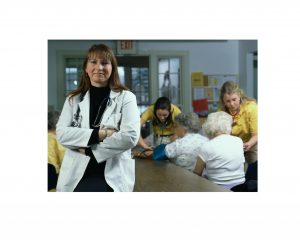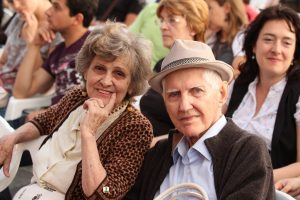Dr. Mauk’s Boomer Blog
Each week, Dr. Kristen Mauk shares thoughts relevant to Baby Boomers that are aimed to educate and amuse.
Dr. Kristen L. Mauk, PhD, DNP, RN, CRRN, GCNS-BC, GNP-BC, FAAN

4 Home Improvements Caregivers Should Make

Paige A. Mitchell
If you’re caring for a family member at home, you’ll want to ensure your house is a safe, healthy environment for everyone involved. You’ll likely have some adjustments to make in order to make your home more comfortable for an ill or impaired loved one. Consider the four home improvements below.
1. Declutter and re-decorate
Keep floors clear of toys and shoes. Strategically rearrange the furniture, so that your loved one is able to remain stimulated and engaged while they sit. For example, they may enjoy some natural sunlight and the view of nature from a comfortable chair near a window. Personal touches and familiar objects can make Alzheimer’s patients more comfortable.
2. Enhanced access
It’s important to review each room in the house to determine how accessible it is to someone who is ill or impaired. The American Association of Retired Persons’ checklist includes zero-threshold and wide entrances for wheelchairs and walkers, low light switches and door knobs that are reachable to someone in a wheelchair, and non-slip flooring and grab bars in at least one bathroom.
3. Maintain your home
Whether you’re caring for someone who is ill or not, it’s important to conduct regular home maintenance to ensure it’s a truly healthy environment. For example, replacing batteries in smoke detectors is especially important if your loved one is forgetful and susceptible to forgetting that something is on the stove. Take full advantage of your home repair insurance to save time, energy, and money on repairs.
4. Ask for help
Fifty percent of caregivers report feeling depressed. If you’re suffering from fatigue, isolation, irritable, and/or ill, it’s important to take a step back to take care of yourself. Don’t forget to ask for help when you need it. Seek an expert opinion for objective advice on whether you should consider placing your loved one in assisted care.
Guest Blog: Senior Citizen Guide to Insurance
Becoming a senior citizen is a time in one’s life where things begin to change, sometimes drastically, and when it comes to important things like insurance, there are quite a few things to consider making sure you have the right insurance and that you can stay within a budget for your medications and general practitioner visits.
If you have ever sat down to compare health insurance plans, you already know how stressful it can be to choose one. There are so many different HMO’s, PPO’s, government plans and private plans and other plans to consider. It can be confusing to understand if you don’t work in the insurance business. Before choosing a plan, you need to determine a few things including:
• Make a list of any pre-existing conditions, if any, that you may have.
• Figure out what you can realistically afford to spend on health care.
• Check into healthcare options offered through work if you still work.
• Check into what Medicare offers, and whether you are eligible based on income for Medicaid or other assistance programs for health care.
Know What You Want
You also need to know the difference in various types of insurance plans.
Health Maintenance Organizations (HMO’s)– HMO’s require you to have all your medical care handled by a provider that is in the HMO’s network.
Preferred Provider Organizations (PPO’s)- a PPO will let you pick your caregiver even if they are not in the network, but the deductible and co-payment will be higher for out of network providers.
Point of service Organizations (POS)– A primary provider will take care of your services, but again, if out of network, the amount you pay will be higher than an HMO.
The best way to compare health insurance plans to choose the one that is right for you is to speak to an insurance agent who can offer the facts for the coverage you need most. Calling a company like Taylor Benefits Insurance, an insurance company that works nationwide, is a good idea to get started on the path to the right insurance plan when you hit those senior years. A good agent can walk you through each plan, explain insurance terms and let you know how much you will spend for covered services that you may need for regular care or even emergencies that may arise.
Diabetes Risk Factors and Treatments
Background
Diabetes mellitus is a common metabolic disorder that affects carbohydrate, lipid, and protein metabolism. It is estimated that about 4.4 to 17.4% percent of adults in the United States have diabetes mellitus (Cory , Ussery-Hall, Griffin-Blake et al., 2010). It is estimated that 11.5 million women and 12.0 million men over the age of 60 have diabetes, but many do not know it. The Indian Health Service reported via the National Diabetes Survey of 2007 that of the 1.4 million Native Americans and Alaska Natives in the United States, 14.2% age 20 years or older have diagnosed diabetes. Rates vary by region, from 6.0% of Alaska Natives to 29.3% of the Native Americans in southern Arizona (CDC, 2007). There are two major types of diabetes, type 1 (T1DM) and type 2 ( T2DM). T1DM is characterized by autoimmune destruction of the insulin-producing beta cells of the pancreas, leading to a deficiency of insulin. New-onset of adult T1DM in older adults rarely happens; however, due to better treatment of T1DM, older adults who have been diagnosed at an earlier age are living longer. About 90% of older adults with diabetes have T2DM, which is often related to obesity. T2DM is characterized by hyperglycemia and insulin resistance; however, impaired insulin secretion may also be present. Diabetes mellitus is a major cause of disability and death in the United States, and is the seventh leading cause of death among older adults.
Risk Factors
The risk of diabetes increases with age (45 years and older). Other risk factors include family history, obesity, race (African Americans, Hispanics, Native Americans, Asian Americans, Pacific Islanders), hypertension, less “good” cholesterol (less than 35 mg/dl), lack of exercise, having a history of delivering large babies (≥9 pounds), personal history of gestational diabetes, and pre-diabetes in men and women (Laberge, Edgren, & Frey, 2011). Type 2 is the most common type in older women (CDC, 2007). The risk of death from DM is significantly higher among older ¬Mexican American, African American, and Native American women when compared to Whites. The Centers for Disease Control CDC (2005) names obesity, weight gain, and physical inactivity as the major risk factors for DM among women.
Diagnosis
The most common presentation for older adults with T1DM is hyperglycemia (high blood sugar). Older adults may not have the classical symptoms such as polydipsia, polyuria, polyphagia, and weight loss. Instead, they may have an atypical presentation (Halter Chang & Halter, et al., 2009). They may first present with falls, urinary incontinence, fatigue, or confusion. Because older adults may have T2DM for years before it is diagnosed, they often have macrovascualar and microvascular complications at the time of diagnosis, so evaluation of these should be considered at that time.
Treatment
Prevention is the best approach to care, which involves identifying those at risk and encouraging lifestyle change. Older adults with diabetes mellitus have a high risk for complications related to macrovascular disease, microvascular disease, and neuropathy. Macrovascular diseases include coronary heart disease, stroke, and peripheral vascular disease, which can lead to amputation. Microvascular diseases are chronic kidney disease, which is the most common cause of end-stage renal disease, and diabetic retinopathy, that which can lead to blindness. Peripheral neuropathy presents as uncomfortable, painful sensations in the legs and feet that are difficult to treat. A lack of sensation may also be present and contribute to the risk of falls. There is no cure for peripheral neuropathy, and it tends to be a complication for which patients experience daily challenges trying to manage the symptoms. A combination of medication to address pain and interventions by a physical therapist seems to be the best current treatment.
Treatment is aimed at helping patients to achieve and maintain glycemic control to decrease risk of complications. The initial treatment approach is to work with the older adult to establish treatment goals aimed at reducing long-term complications. This often requires working within an interprofessional team. Aggressive treatment may be appropriate for most older adults; however the risk of hypoglycemia (low blood sugar) is higher in older adults. Older adults with hypoglycemia may have an atypical presentation with acute onset of confusion, dizziness, and weakness instead of tremors or sweating. The best measure of good blood glucose management and controlled blood sugars is HgbA1c levels (glycosylated hemoglobin). This measure of hemoglobin provides insight into the previous 3 months of blood sugar control. If HgbA1c is elevated, it indicates that the blood sugar has been high over time. For most people, a HgbA1c ≤ 7% indicates optimal glycemic control; however, due to poor health outcomes, for frail older adults or those with a life expectancy ≤ 5 years this may not be the best, and a Hgb A1c of 8% might be more appropriate.
Management is successful when a balance is achieved among exercise, diet, and medications. Medications may be oral hypoglycemics or insulin injection. Insulin injection is used in T1DM and may be prescribed for T2DM because as the person ages, beta-cell function declines. If insulin is needed, it is important to consider if there are visual problems and or hand arthritis that limits the dexterity that is necessary to prepare and inject the medication. For some, a simple regimen, such as premeasured doses and easier injection systems (e.g.,insulin pens with easy-to-set dosages) is the best.
Thorough evaluation of readiness to learn and of the ability of an older person to manage his or her medications must be done. Older adults who need to give themselves insulin injections may experience anxiety about learning this task. Demonstration, repetition, and practice are good techniques for the older age group. Adaptive devices such as magnifiers may help if the syringes are hard to read. A family member should also be taught to give the insulin to provide support and encouragement, although the older adult should be encouraged to remain independent in this skill if possible. Williams and Bond’s (2002) research suggested that programs that promote confidence in self-care abilities are likely to be effective for those with diabetes. A plan for times of sickness and the use of a glucometer to monitor blood sugars will also need to be addressed. Additionally, the dietician may be consulted to provide education for the patient and family on meal planning, calorie counting, carbohydrate counting, and nutrition. Many patients benefit from weight loss, so the nutritionist can assist with dietary planning in this regard also.
Due to the increased risk of infection and slow healing that result from diabetes, foot care is an essential component in teaching older adults to manage DM. Some experts believe that good preventive foot care would significantly reduce the incidence of amputation in the elderly. Older persons with DM should never go barefoot outside. Extremes in temperature should be avoided. Shoes should be well fitting and not rub. Socks should be changed regularly. Elders should be taught to inspect their feet daily, with a mirror if needed. Corns and ingrown toenails should be inspected and treated by a podiatrist, not by the patient. Older persons should see their podiatrist for a foot inspection at least yearly. Patients should be cautioned that even the smallest foot injury, such as a thorn or blister, can go unnoticed and unfelt—and often results in partial amputations that lead to a cascade of lower extremity problems.
http://www.diabetes.org
Adapted from Mauk, K. L., Hanson, P., & Hain, D. (2014). Review of the management of common illnesses, diseases, or health conditions. In K. L.
Mauk’s (Ed.) Gerontological Nursing: Competencies for Care. Sudbury, MA: Jones and Bartlett Publishers. Used with permission.
Pneumonia Information

According to the CDC (2010), chronic lower respiratory disease and pneumonia with influenza are the third and ninth leading causes of death, respectively, among older adults. Older adults 65 and older are more often affected by these disorders than younger adults, and the risk of death from pneumonia increases with age. In 2005, there were 651,000 hospital discharges of males diagnosed with pneumonia and 717,000 discharges of females, with greater than 62,000 deaths attributed to pneumonia (American Lung Association [ALA], 2008). The majority of these cases occurred in those age 65 and older, with the elderly having 5–10 times the risk of death from pneumonia as younger adults (Kennedy-Malone, Fletcher, & Plank, 2004).
Pneumonia is an infection of the lung that can be caused by bacteria, viruses, or mycoplasmas. The two most common ways to get pneumonia are through inhalation of droplet particles carrying infectious germs and aspiration of secretions of the nose or mouth areas. Older adults are at higher risk for pneumonia and can get a more serious infection if they also have other chronic diseases such as COPD, heart failure, a suppressed immune system, cerebrovascular disease, and poor mobility (ALA, 2012). The incidence of community-acquired pneumonia (CAP) among people age 65 and older is about 221.3 per 10,000 (ALA, 2008). Streptococcus is the most common bacterial cause, with about 50% of people with CAP requiring hospitalization (Weinberger, 2004). When hospitalized, older people are at risk for poor health outcomes, including respiratory failure requiring ventilator support, sepsis, and longer length of hospitalization, duration of antibiotic therapy and other supportive treatment (ALA, 2012).
Warning signs
The onset of bacterial pneumonia can be sudden or gradual; however, older adults may not present with the typical symptoms of chills, fever, chest pain, sweating, productive cough, or shortness of breath. Instead, they may have a sudden change in mental status (confusion/delirium). Cases of viral pneumonia account for about half of all types of pneumonia and tend to be less severe than bacterial pneumonia. Symptoms of viral pneumonia include fever, nonproductive hacking cough, muscle pain, weakness, and shortness of breath.
Diagnosis
Diagnosis is made through chest x-ray, complete blood count, and/or sputum culture to determine the type and causal agents (if bacterial). A thorough history and physical that includes assessment of swallowing ability and eating (watch for coughing while eating) to evaluate for aspiration risk should be done. Crackles may be heard in the lungs through a stethoscope, and chest pain with shortness of breath may be present.
Treatment
Bacterial pneumonia can often be treated successfully when detected early, and viral pneumonia generally heals on its own (antibiotics are not effective if pneumonia is caused by a virus), though older adults may experience a greater risk of complications than younger adults. Oral antibiotics will significantly help most patients with bacterial pneumonia.
Aspiration pneumonia is caused by inhalation of a foreign material, such as fluids or food, into the lungs. This occurs more often in persons with impaired swallowing. For older adults receiving tube feedings, care must be taken to avoid having the person in a laying position during and immediately after tube feeding because aspiration can occur; it is important to note that tube feedings do not reduce the risk of aspiration. Having the head of the bed elevated or, even better, the person in a sitting position when eating or receiving nutrition through a feeding tube, helps to avoid the potential complication of pneumonia related to aspiration.
When recovering from pneumonia, one should get plenty of rest and take adequate fluids to help loosen secretions (with accommodations made to support the added need to urinate due to the increased fluid intake, a common reason why older adults may not drink adequate fluids). Tylenol or aspirin (if not contraindicated by other conditions) can be taken to manage fever as well as aches and pains. Exposure to others with contagious respiratory conditions should be avoided. Respiratory complications are often what lead to death in the older adults, so they should be cautioned to report any changes in respiratory status such as increased shortness of breath, high fever, or any other symptoms that do not improve. It is important to follow up with the physician or nurse practitioner and get a chest x-ray if ordered, since symptoms may improve with treatment before the pneumonia is actually completely gone.
Prevention of pneumonia is always best. Adults over the age of 65 are advised to get a pneumonia vaccine. Persons younger than age 65 who have higher risk (those with respiratory problems or persons in nursing homes) should get the vaccination. A yearly flu vaccine is also recommended for older adults, because pneumonia is a common complication of influenza in this age group. Medicare will cover these vaccines for older persons.
GERD
Background
Although gastroesophageal reflux disease (GERD) is common among older adults, the true prevalence is not known. Many patients with GERD-related symptoms never discuss their problems with their primary care provider. GERD is thought to occur in 5–7% of the world’s population, with 21 million Americans affected (International Foundations for Functional Gastrointestinal Disorders, 2008). It is found in both men and women.
Signs and symptoms
Pathophysiological changes that occur in the esophagus, hiatal hernia, and certain medications and foods increase the risk for GERD. Obesity (Corely , Kubo, Levin et al., 2007) and activities that increase intra-abdominal pressure such as wearing tight clothes, bending over, or heavy lifting have also been linked to GERD (MedlinePlus, 2005a). The cardinal symptom of GERD is heartburn; however, older adults may not report this, but rather complain of other symptoms such as pulmonary conditions (bronchial asthma, chronic cough, or chronic bronchitis), a hoarse voice, pain when swallowing foods, chronic laryngitis, or non-cardiac chest pain (Pilotto & Franceschi, 2009). The chronic backflow of acid into the esophagus can lead to abnormal cell development (Barrett esophagus) that increases the risk for esophageal cancer.
Diagnosis
Older adults often have atypical symptoms, making the diagnosis of GERD very challenging. As people age, the severity of heartburn can diminish, while the complications, such as erosive esophagitis, become more frequent. Therefore, endoscopy should be considered as one of the initial diagnostic tests in older adults who are suspected of having GERD (Pilotto & Franceschi, 2009). Examination of the esophagus, stomach, and duodenum through a fiber-optic scope (endoscopy) while the person receives conscious sedation, allows the gastroenterologist to visualize the entire area, identify suspicious areas, and obtain biopsies as needed. Helicobacter pylori (H. pylori), a chronic bacterial infection in humans, is a common cause of GERD, affecting about 30% to 40% of the U.S. population. Testing for H. pylori can be done during the endoscopy or by other tests (Ferri, 2011).
Treatments
The objectives of treatment for GERD include: (1) relief of symptoms, (2) healing of esophagitis, (3) prevention of further occurrences, and (4) prevention of complications (Pilotto & Francheschi, 2009). Lifestyle and dietary modifications are important aspects of care. It is widely recommended that persons with GERD should stop smoking, limit or avoid alcohol, and limit chocolate, coffee, and fatty or citrus foods. Medications should be reviewed and offending medications modified, since certain medications decrease the lower esophageal sphincter (LES) tone, allowing acid to backflow into the esophagus. These include anticholinergic drugs, some hormones, calcium channel blockers, and theophylline. Avoidance of food or beverages 3–-4 hours prior to bedtime, weight loss, and elevation of the head of the bed on 6-to-8 inch blocks are some other interventions that may help alleviate symptoms. Pharmacological treatments with antacids in conjunction with histamine 2 (H2) -blockers (Tagmet, Zantac, Axid, and Pepcid) are used for mild GERD. If these are ineffective in controlling symptoms, then the proton pump inhibitors (PPIs) are the next drugs of choice. These include medications like Nexium and Dexilant. With lifestyle modifications and appropriate medications, older adults can manage their GERD symptoms so that quality of life is maintained.
Adapted from Mauk, K. L., Hanson, P., & Hain, D. (2014). Review of the management of common illnesses, diseases, or health conditions. In K. L. Mauk’s (Ed.) Gerontological Nursing: Competencies for Care. Burlington, MA: Jones and Bartlett Publishers. Used with permission.
http://www.mayoclinic.com/health/gerd/DS00967



